biology - genetics (3.1, 3.2, 3.11 - 3.23)
1/41
There's no tags or description
Looks like no tags are added yet.
Name | Mastery | Learn | Test | Matching | Spaced |
|---|
No study sessions yet.
42 Terms
3.1 advantages of asexual reproduction
lack of need to find a mate - more time & energy efficient
rapid reproductive cycle
3.1 disadvantages of asexual reproduction
no variation in population - species only suited to one habitat, disease may effect all individuals in population
3.2 advantages of sexual reproduction
variation in population - survival advantage as species can adapt to environmental changes, disease less likely to affect all individuals in population
3.2 disadvantages of sexual reproduction
requirement to find a mate - uses time & energy, isolated individual cannot reproduce (extinction)
slower reproductive cycle
asexual reproduction
mitosis, 1 parent
sexual reproduction
meiosis, 2 parents, fusion of male & female gametes
3.11 how did Mendel observe characteristic in pea plants?
bred pea plants together using a paintbrush to move pollen (containing male gametes) from one plant to flower of another
bag placed over flower on plant & sealed (no cross-contamination)
planted seeds that formed & observed characteristics of offspring
3.11 Mendel’s conclusions
concluded inherited ‘factors’ control variation of characteristics
factors exist in different versions (alleles) that do not change
plant has 2 factors for each characteristics (either same version/2 different versions)
plants with 2 factors of same version: true-breeding; if plant was self-pollinated, offspring all had same variation as parent
3.11 Mendel’s 3 laws of inheritance
each gamete receives only one factor for a characteristic
the version of a factor a gamete receives is random & doesn’t depend on other factors in gamete
some versions of a factor are more powerful than other & always have an effect in offspring
3.11 difficulties understanding inheritance
Mendel’s work mostly not accepted
scientists didn’t understand how ‘factors’ could explain the many variations in characteristics like human eye colour
also how his ideas could explain Darwin’s theory of evolution - argued if factors couldn’t change, species couldn’t change/evolve
once chromosomes discovered (1880s) scientists started understanding how Mendel’s factors could work
3.12 why are there differences in inherited characteristics?
there’s 2 copies of every chromosome in a body cell nucleus
so a body cell contains 2 copies of every gene
each copy of a gene may be a different allele
different combination of alleles in each person gives everyone slightly different characteristics (genetic variation)
3.13 chromosome
long coiled molecule of DNA carrying genetic information in the form of genes
3.13 gene
section of DNA on a chromosome that codes for a particular protein
3.13 allele
different forms of the same gene
3.13 dominant
a dominant allele is always expressed, capital letter
3.13 recessive
a recessive allele is only expressed if two copies are present (no dominant allele), lowercase letter
3.13 homozygous
both alleles for one gene are the same
3.13 heterozygous
both alleles for one gene are different
3.13 genotype
organism’s genetic composition - combination of alleles that control each characteristic
3.13 phenotype
organism’s observable characteristics
3.13 gamete
sex cells (sperm & egg) with 23 chromosomes
3.13 zygote
diploid cell formed by fusion of nucleus of male gamete with nucleus of female gamete
monohybrid inheritance
the inheritance of one gene
3.14 monohybrid inheritance - genetic diagrams

3.14 monohybrid inheritance - Punnett squares
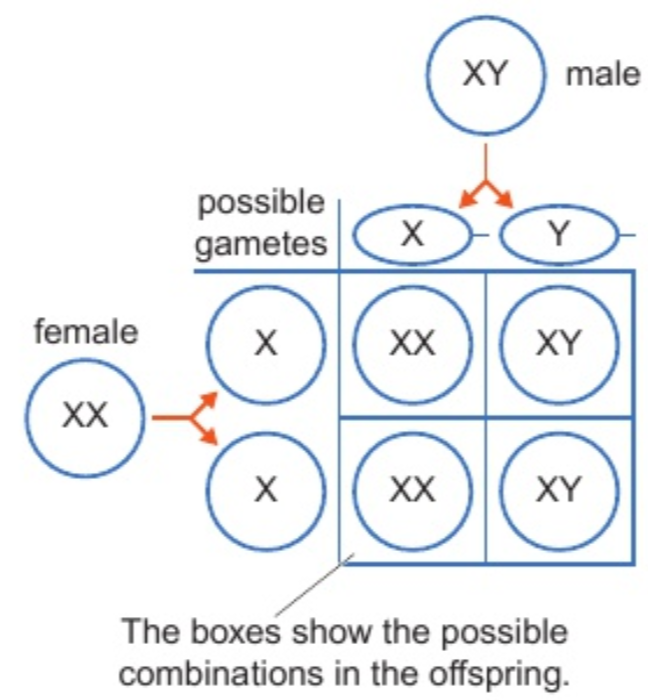
3.14 monohybrid inheritance - family pedigrees
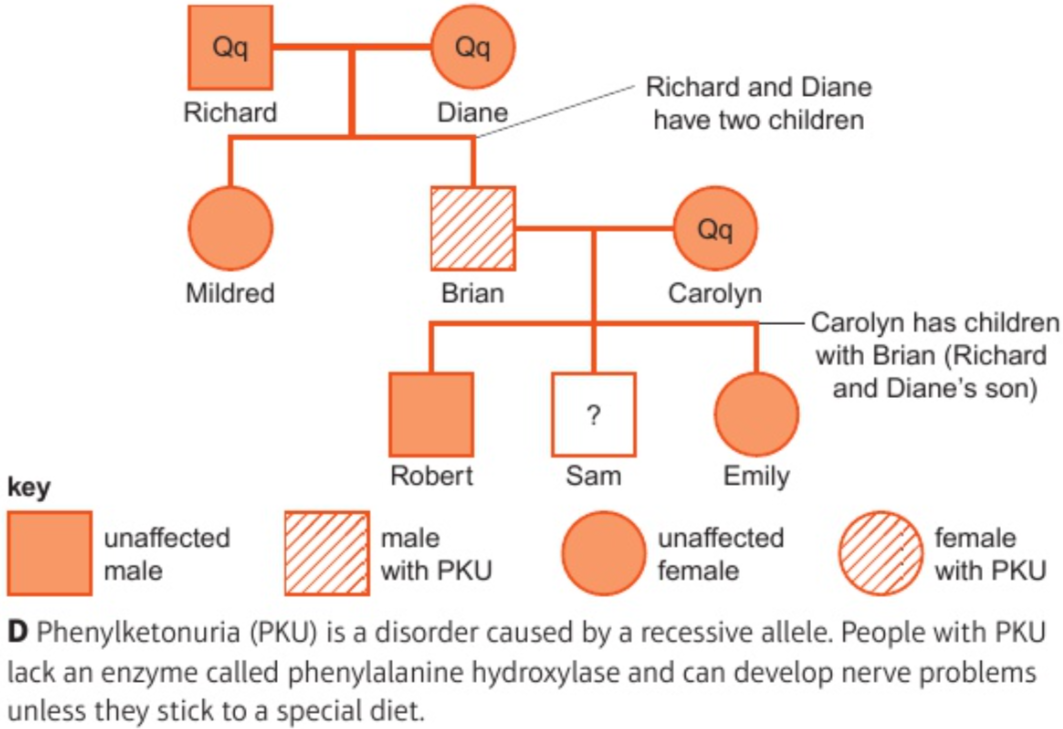
3.15 how is the sex of offspring determined at fertilisation?
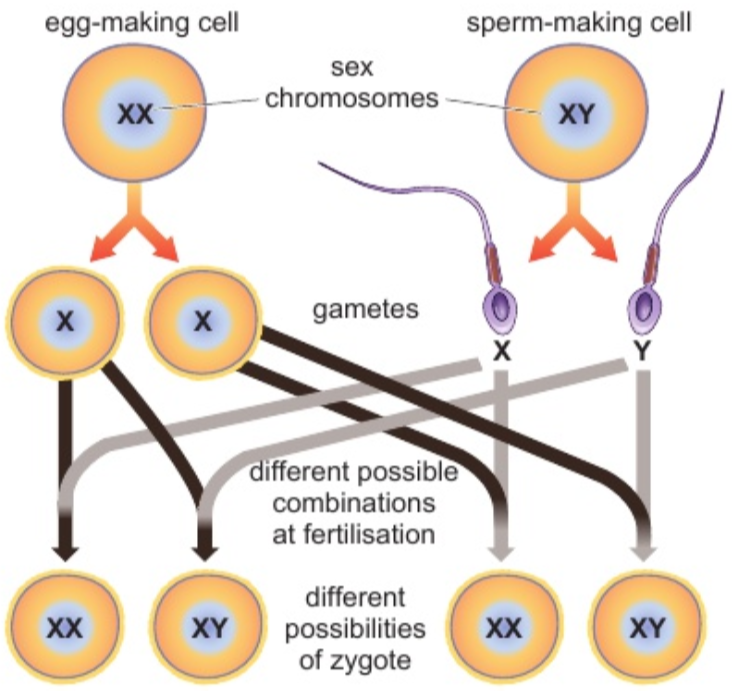
3.16 Calculating probabilities, ratios & % for dominant & recessive traits

4 different blood groups
A, B, AB, O
how is blood group determined?
‘marker molecules’ on outside of RBCs
3 main types of markers: A, B, O
3.17 inheritance of ABO blood groups
gene responsible for markers in ABO system has 3 alleles: IA, IB, IO
everyone has 2 copies of the gene, so can be: homozygous for any of the 3 alleles; heterozygous for any 2 of the 3 alleles
person with genotype IAIB shows effects of both alleles so has blood group AB
3.17 codominance
when both alleles for a gene affect the phenotype (e.g. AB blood group)
3.18 how are sex-linked genetic disorders inherited?
chromosomes in diploid cells come in pairs
in most pairs chromosomes have same genes
however human Y sex chromosome is missing some genes found on X chromosome
so man (XY) will have only one allele for some genes on X chromosome (because those genes are missing on Y chromosome)
if allele for one of these X chromosome genes causes a genetic disorder, man will develop disorder
if woman inherits ‘disorder’ allele, she may have ‘healthy’ allele on other X chromosome
if ‘disorder’ allele is recessive, won’t get disorder
if she inherits 2 recessive alleles, will get disorder
probability woman getting disorder < probability man getting disorder
3.19 what are phenotypic features a result of?
most phenotypic features are the result of multiple genes rather than single gene inheritance (e.g. several genes affect eye colour in humans)
mutation
a change in a gene that creates a new allele
3.20 causes of variation that influence phenotype - genetic variation
different characteristics as a result of mutation & sexual reproduction
different alleles inherited during sexual reproduction
different alleles are produced by mutations (some cause changes in phenotype)
3.20 causes of variation that influence phenotype - environmental variation
different characteristics caused by an organism’s environment (acquired characteristics) - e.g. loss of limb
continuous variation
data can be any value in a range - e.g. leaf length
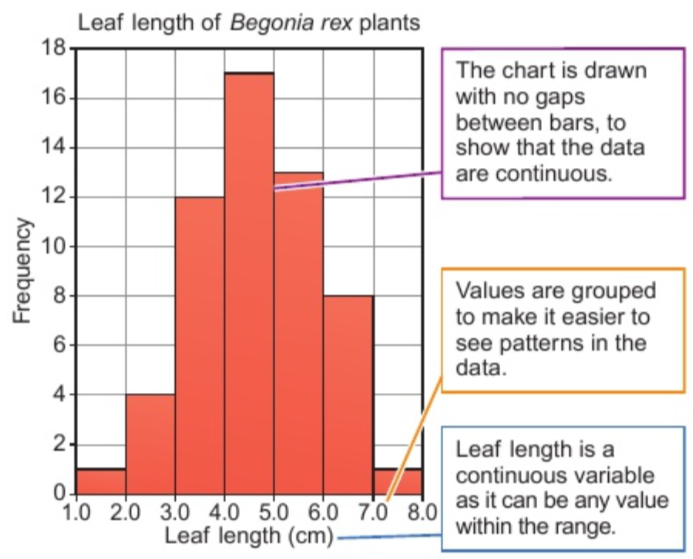
discontinuous variation
data can only take a limited set of values - e.g. number of whole leaves
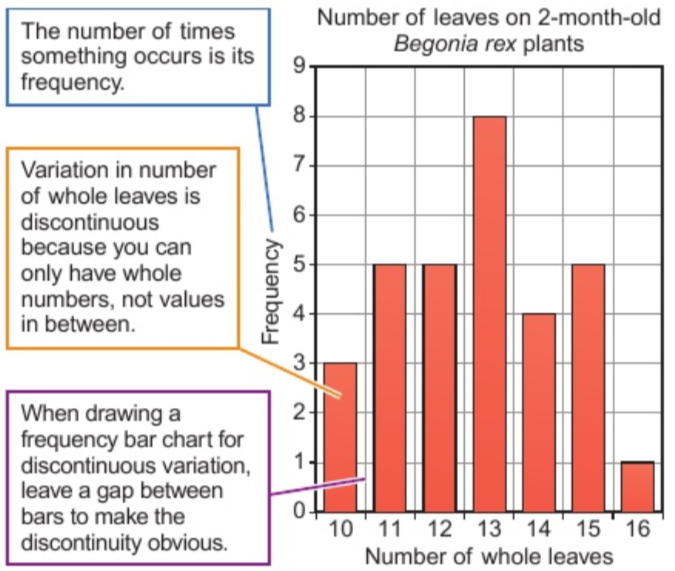
3.21 Human Genome Project - outcomes & potential applications in medicine
produced map of complementary base pairs in 1 set of 46 human chromosomes
found many sections of DNA that are the genes
mapped other human genomes
showed there’s variations between people, but over 99% of DNA bases in different people are the same
indicates people’s risk of developing diseases caused by different alleles of genes
helps identify which medicines might be best to treat person’s illness - alleles we have can affect how medicines work in body
3.22 genetic variation in population of species
usually extensive genetic variation within population of species & these arise through mutations
3.23 effect of mutations on phenotype
most genetic mutations have no effect on phenotype
some mutations have small effect on phenotype
rarely single mutation will significantly affect phenotype